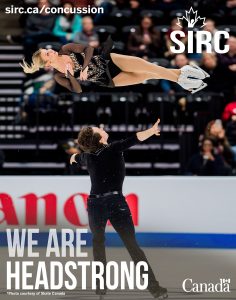Changing the Sport Culture by Changing the Rules
October 15, 2019
High-level athletes compete to win. Sometimes, however, they make rash decisions in the heat of the moment that can have serious, long-term consequences.
Take figure skating, for example. There have been instances in the past where athletes and coaches were suspected of downplaying concerns about head injury because interrupting a skater’s program would have resulted in a large point deduction.
Rather than risk losing the points, athletes would “shake it off” and continue the program, often with the blessing of the coach and the parents.
“We were seeing situations where a skater had clearly hit their head on the ice but would try to bounce back up and continue the program without recognizing the potential harm,” says Amy Levac, Safe Sport Coordinator for Skate Canada. “Pumped up with adrenalin, the athlete could often complete the program, but you could see afterwards that an injury had occurred. Sure, it’s nice to win a medal, but we have to change the culture so that an athlete’s health always comes before anything else, including winning.”
So, Skate Canada changed the rules.
Under the new regime, if the referee is concerned that a skater may have sustained a head injury, the program can be stopped, and the athlete instructed to be assessed for concussion by a qualified individual. If the athlete is cleared, then the program continues – with no deduction to the skater’s score.
Levac emphasizes the importance of taking the decision out of the hands of the athlete, coach or parent, and giving that responsibility to an objective referee.
“The assessment has to happen pretty quickly – within 3 minutes,” she adds. “But the point is that concrete steps are being taken to ensure that an athlete with a potential head injury is prevented from making things worse by continuing to skate. Trying to finish a program with concussion symptoms could be disastrous.”

The updated rules are part of a broader program that includes educational videos and policies on proper use of equipment. For example, helmets are mandatory until skaters have achieved a specific level in the CanSkate program; after that, athletes have the option to continue to wear them.
“We’ve had really strong support from senior management and our Board of Directors for years,” notes Levac. “And all of these initiatives have been well received by parents and coaches because the culture is changing, and everybody sees the need to be doing everything possible to prevent concussions in our sport.”
This blog is part of SIRC’s #HeadstrongCanada concussion awareness, prevention and management campaign. The campaign features tools, resources, and best practices in managing and preventing concussions in sport in Canada. Developed in partnership with Sport Canada, Public Health Agency of Canada and other organizations, the toolkit offers credible information and templates recognized by stakeholders throughout the sport system.
Check out the concussion website for concussion information and tools to help your sport be concussion smart. For concussion information directly to your inbox, sign up for SIRC’s concussion newsletter.
About the Author(s)
Derek Johnston is the President of Face Value Communications Inc. Over the last 20 years, Face Value has supported more than 20 different national and multi-service sport organizations with strategic communications advice, facilitation and executive coaching. As a volunteer, Derek has served on Team Canada Mission Staff at multiple Major Games in places like Australia, Malaysia and the UK, and has coached soccer and triathlon for a total of 25 years.
Peter Morrow is SIRC’s Communications Specialist, leading the dissemination of SIRC’s research, information and resources into the sport community level. He is a multi-sport athlete involved in soccer, hockey, golf and tennis.
The information presented in SIRC blogs and SIRCuit articles is accurate and reliable as of the date of publication. Developments that occur after the date of publication may impact the current accuracy of the information presented in a previously published blog or article.
